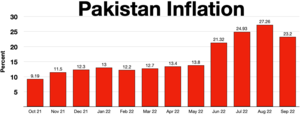| Revision as of 23:00, 11 December 2022 editMako001 (talk | contribs)Extended confirmed users, New page reviewers, Pending changes reviewers, Rollbackers103,332 editsm Reverted edits by 185.231.205.183 (talk) to last revision by 194.156.98.3: unexplained content removalTags: Rollback SWViewer [1.4]← Previous edit | Revision as of 23:01, 11 December 2022 edit undo185.231.205.183 (talk)No edit summaryNext edit → | ||
| Line 11: | Line 11: | ||
| ==Background== | ==Background== | ||
| ] per capita development in India, Pakistan and Bangladesh up to 2018]] | ] per capita development in India, Pakistan and Bangladesh up to 2018]] | ||
| Pakistan's economic crisis was at the centre of a political standoff between Prime Minister ] and his predecessor ] earlier this year, which led to ] in April 2022. Sharif accused Khan of economic mismanagement and mishandling of the country's foreign policy, forcing him to step down in a no-confidence vote. | Pakistan's economic crisis was at the centre of a political standoff between Prime Minister ] and his predecessor ] earlier this year, which led to ] in April 2022. Sharif accused Khan of economic mismanagement and mishandling of the country's foreign policy, forcing him to step down in a no-confidence vote. | ||
Revision as of 23:01, 11 December 2022
Current economic crisis in Pakistan
Inverted yield curve in 2019-2020 and 2022 20 year 10 year 5 year 1 year

The 2022 Pakistan economic crisis is an ongoing economic crisis in Pakistan, that has caused severe economic challenges for months due to which food, gas and oil prices have risen. Russia's war in Ukraine has caused even more energy problems in the country as inflation is at all time high.
Background

Pakistan's economic crisis was at the centre of a political standoff between Prime Minister Shahbaz Sharif and his predecessor Imran Khan earlier this year, which led to Khan's ouster in April 2022. Sharif accused Khan of economic mismanagement and mishandling of the country's foreign policy, forcing him to step down in a no-confidence vote.
Timeline
| This section below this notice needs additional citations for verification. Please help improve this article by adding citations to reliable sources in this section below this notice. Unsourced material may be challenged and removed. Find sources: "Pakistani economic crisis" 2022–present – news · newspapers · books · scholar · JSTOR (July 2022) (Learn how and when to remove this message) |
Information Minister Maryam Aurangzeb told a news conference on 19 May 2022, that last month, Pakistan was committed to "controlling rising inflation, stabilizing foreign exchange reserves, strengthening the economy and reducing the country's dependence on imports". Import of unnecessary and luxury items was banned. Sharif had said at the time that the decision would "save the country's precious foreign exchange" and that Pakistan would have to "pursue austerity."
In late May 2022, the government lifted the cap on fuel prices - a condition for advancing the long-stalled bailout deal with the International Monetary Fund (IMF). IMF also insisted Islamabad to raise electricity prices, ramp up tax collection and make sizeable budget cuts.
Federal Minister for Planning and Development Ahsan Iqbal told reporters on 14 May 2022, that Pakistanis could reduce their tea consumption to "one or two cups" a day as imports were putting additional financial pressure on the government. "The tea we import is imported on credit," Iqbal said, adding that businesses should be shut down first to save electricity. According to the Observatory of Economic Complexity, the South Asian nation of 220 million is the world's largest tea importer, having bought more than $ 640 million worth of tea in 2020.
Inflation in Pakistan rose to 21.3% in June, the highest since December 2008 when inflation stood at 23.3%.
Finance Minister Miftah Ismail said that a loan of $2.3 billion from a Chinese consortium of banks had been credited to the Pakistani central bank's account in late June.
2022 Pakistan floods in summer cause over $30 billion dollars in economic losses in Pakistan.
The consistent depreciation of the rupee is deepening the economic crisis in Pakistan, and the country “in financial emergency”.
Federal budget
Main article: 2022–23 Pakistan federal budgetOn 10 June 2022, the government unveiled a new 47 billion budget for 2022-23 to persuade the IMF to resume the 6 billion bailout deal, which was agreed upon by both sides in 2019.
See also
References
- "Economic crisis and default fear". 12 June 2022.
- "Goods transporters suspend nationwide operations after fuel hike". 16 June 2022.
- "'Emergency situation': In a first, complete ban imposed on non-essential items, says Marriyum Aurangzeb".
- "Pakistan's foreign policy reset hits a dead end". The Australian Strategic Policy Institute. Retrieved 13 July 2022.
- Mogul, Rhea (June 15, 2022). "Pakistanis told to drink less tea as nation grapples with economic crisis". CNN.
- Islamabad, Associated Press in (June 15, 2022). "Pakistanis told to drink less tea to help fight economic crisis". the Guardian.
- ^ "Pakistan Inflation Hits 21.32% in June on Costly Oil". Bloomberg. Retrieved 1 July 2022.
- "$2.3 bn Chinese loan credited to State Bank of Pakistan: Finance minister". Business Standard. Retrieved 25 June 2022.
- "Pakistan suffers over 30 bln USD loss to economy due to floods: minister". Xinhua.
- "'Pakistan in financial emergency'". The Express Tribune. Retrieved 6 December 2022.
- "Pakistan's New Budget Aims to Please the IMF".